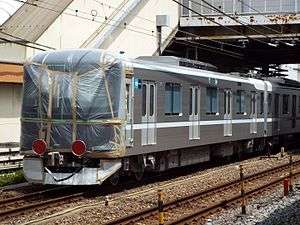Tokyo Metro 13000 series
| Tokyo Metro 13000 series | |
|---|---|
|
The first 13000 series set, 13101, on delivery in June 2016 | |
| Manufacturer | Kinki Sharyo |
| Replaced | 03 series |
| Constructed | 2016– |
| Entered service | Fiscal 2016 (scheduled) |
| Number under construction | 301 vehicles (43 sets) |
| Number built | 14 vehicles (2 set) |
| Formation | 7 cars per trainset |
| Fleet numbers | 13101– |
| Capacity | 1,035 |
| Operator(s) | Tokyo Metro |
| Depot(s) | Senju |
| Line(s) served | |
| Specifications | |
| Car body construction | Aluminium |
| Car length | 20,000 mm (65 ft 7 in) |
| Width | 2,780 mm (9 ft 1 in) |
| Height | 3,995 mm (13 ft 1.3 in) |
| Floor height | 1,140 mm (3 ft 9 in) |
| Doors | 4 pairs per side |
| Maximum speed | 110 km/h (70 mph) |
| Power output | 205 kW x 2 per car |
| Acceleration | 3.3 km/h/s |
| Deceleration |
3.7 km/h/s (service) 4.5 km/h/s (emergency) |
| Electric system(s) | 1,500 V DC overhead line |
| Safety system(s) | Tobu ATS |
| Track gauge | 1,067 mm (3 ft 6 in) |
The Tokyo Metro 13000 series (東京地下鉄13000系 Tōkyō Chikatetsu 13000-kei) is a Japanese DC commuter electric multiple unit (EMU) train type on order by the Tokyo subway operator Tokyo Metro for use on Tokyo Metro Hibiya Line and Tobu Skytree Line inter-running services from fiscal 2016.[1]
Overview
A total of 44 seven-car 13000 series trains (294 vehicles) are scheduled to replace the 03 series EMUs used on Tokyo Metro Hibiya Line and Tobu Skytree Line inter-running services.[2] The new trains have 20 m (65 ft 7 in) long cars instead of the 18 m (59 ft 1 in) long cars of the 03 series, and a unified door arrangement with four pairs per side instead of the mixture of three and five pairs per side on the 03 series trains.[2] This will allow platform edge doors to be installed at Tokyo Metro Hibiya Line stations once the older train fleets have been replaced.[2] The trains use PMSM (permanent magnet synchronous motors), offering 25% energy savings compared to the motors used in earlier 03 series trains.[2]
Formation
The 13000 series trains are formed as seven-car sets, as shown below, with car 1 at the Kita-Senju (northern) end.[2] Each car is motored, with only the outer axle on each bogie motored.[2]
| Car No. | 1 | 2 | 3 | 4 | 5 | 6 | 7 |
|---|---|---|---|---|---|---|---|
| Designation | CM2 | M1' | M2' | M3 | M2 | M1 | CM1 |
| Numbering | 130xx | 136xx | 135xx | 134xx | 133xx | 132xx | 131xx |
| Weight (t) | 35.0 | 33.4 | 33.6 | 35.4 | 33.3 | 33.5 | 34.9 |
| Capacity (total/seated) | 140/45 | 151/51 | 151/51 | 151/51 | 151/51 | 151/51 | 140/45 |
Car 4 has two single-arm pantographs, and cars 2 and 6 each have one.[2]
Interior
Internally, the trains use LED lighting throughout. Three 17-inch LCD passenger information displays are provided above each doorway, with information given in four languages (Japanese, Chinese, English, Korean).[2] Seating consists of longitudinal bench seats throughout, with a seat width of 460 mm (18 in) per person (compared to 430 mm per person for the 03 series).[1] Wheelchair spaces are provided at one end of each car.[1]
History
Tokyo Metro announced its plans to introduce a new fleet of trains with 20 m long cars and four sets of doors per side on each car in April 2014, jointly with Tobu Railway.[3] Details of the new 13000 series trains on order were officially announced on 17 June 2015, together with details of the Tobu 70000 series to be introduced around the same time.[1] The entire fleet of 44 trains (308 vehicles) is scheduled to be delivered between fiscal 2016 and fiscal 2020.[2]
The first set, 13101, was delivered from the Kinki Sharyo factory in Osaka to Tokyo Metro's depot at Ayase in June 2016,[4] and was officially shown off to the media on 31 August 2016.[5]
References
- 1 2 3 4 5 6 7 8 9 東京地下鉄13000系 [Tokyo Metro 13000 series]. Japan Railfan Magazine (in Japanese). Vol. 56 no. 667. Japan: Koyusha Co., Ltd. November 2016. p. 73-75.
- ↑ Kurihara, Kageri (26 July 2014). 君は日比谷線の新型車両を知っているか 東京メトロと東武鉄道が2016年度から導入 [Do you know about the new trains for the Hibiya Line? To be introduced by Tokyo Metro and Tobu from 2016]. Toyo Keizai Online (in Japanese). Japan: Toyo Keizai Inc. Retrieved 20 June 2015.
- ↑ 東京メトロ13000系第1編成が甲種輸送される [First Tokyo Metro 13000 series set delivered]. Japan Railfan Magazine Online (in Japanese). Japan: Koyusha Co., Ltd. 12 June 2016. Archived from the original on 12 June 2016. Retrieved 12 June 2016.
- ↑ 東京メトロ、日比谷線の新型車両「13000系」公開…7両4ドアに統一へ [New Tokyo Metro Hibiya Line 13000 series train unveiled]. Response (in Japanese). Japan: IID Inc. 31 August 2016. Archived from the original on 31 August 2016. Retrieved 31 August 2016.
External links
| Wikimedia Commons has media related to Tokyo Metro 13000 series. |
- Official press release (Japanese)
- Kinki Sharyo press release (Japanese)

